Water Wise It ™ – Creating a Water-Wise Lawn!
Maintaining a healthy lawn is the best defense against weeds and foreign grasses. Follow these maintenance tips to create a Healthy, Water-Wise Lawn.
Having a perfectly weed free lawn is an unrealistic expectation and should not be something to get frustrated over, but measures definitely can be taken to improve your yard. The best measure for controlling weeds is to create a healthy lawn and care for it with proper maintenance practices. Proper fertilizing, aeration, mowing, and irrigation all promote the healthy growth of the grass in your lawn.
Have you ever found mushrooms on your lawn? The cause is over watering or poor drainage!
Watering your lawn properly will not only help it look greener, but it will help control common diseases and weeds that would otherwise become present like mushrooms. Overwatering a lawn is one of the leading causes of excess thatch (which prevents air water and nutrients from reaching the roots of your lawn) and mushroom growth. When you have standing water on your lawn, caused by compacted soils not allowing filtration or over watering, you will often see mushroom growth. Decrease the amount of water on the affected part of your lawn and aerate if necessary to fix the problem.
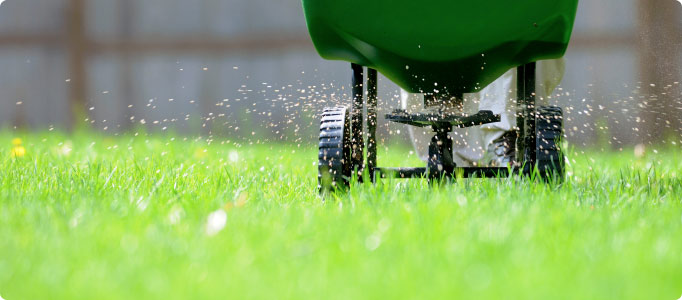
Fertilizing
Landscape Maintenance Companies often promote 5 or more fertilizer applications per year, and if you do it yourself you will often see a 4-Step Program advertised. Lawns need between 2#s- 4#s of available Nitrogen per 1,000 square feet in a year. Nitrogen helps keep your lawn a verdant green which aids in photosynthesis and helps the plant regrow after mowing. You should observe your lawn and only apply fertilizer when you observe that the color of the lawn has lightened considerable, you are getting lots of weeds in the lawn, if the lawn seems thin in multiple areas, or if it doesn’t recover quickly after mowing. The most important fertilization of the year is the Winterizer that you apply late in the Fall! If you choose to do only one fertilization during the year, this is the one you should do. For more information on fertilizing your lawn download our Fertilization Guide here. Fertilizing_and_Watering
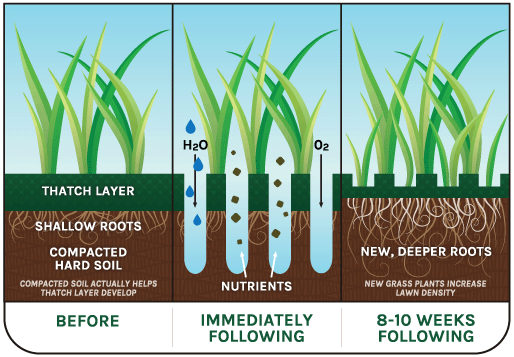
Aeration
Aeration should be done on every lawn at least once a year, preferably in the Spring. If you have a soil bed that compacts easily 2-3 times are recommended, either Spring and late Fall, or early Spring, mid-Summer, and Early Fall. Sports Fields, Parks or any lawn that receives heavy foot traffic can benefit from 2-3 aerations in a year. Plug aeration is recommended for residential lawns and moderate traffic lawns. Sports fields are usually installed over sandy or sandy loam soil and can benefit greatly from deep tine aeration. Aeration loosens up soil and allows Air, Water, and Nutrients to be easier access to the roots of the lawn. This also allows the lawn to build a stronger root system which chokes out weeds and foreign grasses.
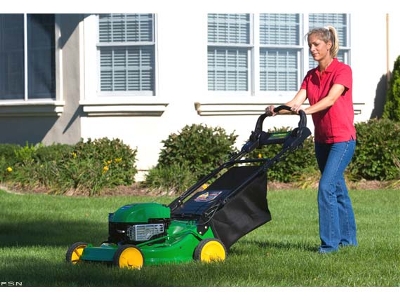
Mowing
Mowing a lawn properly affects how much water a lawn requires. Grass clippings are made of approximately 70% water and 30% organic material, so returning the clippings to the lawn by mulching them is recommended. Mowing your lawn the right way will decrease the amount of water and fertilizer that you will need to apply. Here are some recommendations:
- Mulch your clippings! As mentioned above mulching your clippings will return water and organic material to your lawn and decrease the amount of fertilizer you need to apply.
- Mow 2-3″ high. A longer lawn will promote deeper roots, decrease evaporation by shading the top of the soil bed, and give your lawn a softer feel.
- Sharpen your blade at least once a year. A dull blade will tear the blades making it harder for the lawn to regrow. If your blade is dull you will notice the ends turn yellow shortly after you mow the lawn. A sharp blade will help your lawn to regrow quicker and remain green longer.
- Never mow more than 1/3 of the blade at a time. Mowing more than this will put your lawn into shock and all the plants energy will be refocused on regrowth of the blade which will prevent your roots from growing as quickly.
- Mow in different directions each time. This will give your lawn a more uniform appearance and will help prevent compaction.
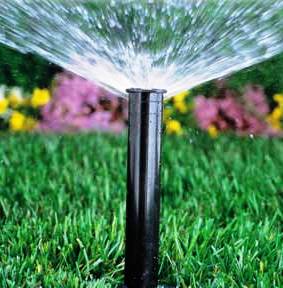
Irrigation
Watering your lawn is not a difficult process. The average homeowner in Utah applies upwards of 50″ of water to their lawn each year! However, a healthy cool season lawn can remain green through the heat of the summer with 24-26″ of supplemental water each year. Follow the watering guide below to minimize the amount of water you apply to your lawn. Unless you start following this watering guide early in the spring you may not be able to follow this watering guide completely. If you lawn cannot survive on this schedule you can start adding days between watering and lengthening the time your sprinklers are running on those days, then decrease the amount of water applied to your lawn once it is trained to go longer between irrigation, to arrive at the recommended amounts. Below the Lawn Watering Chart are some other great tips.
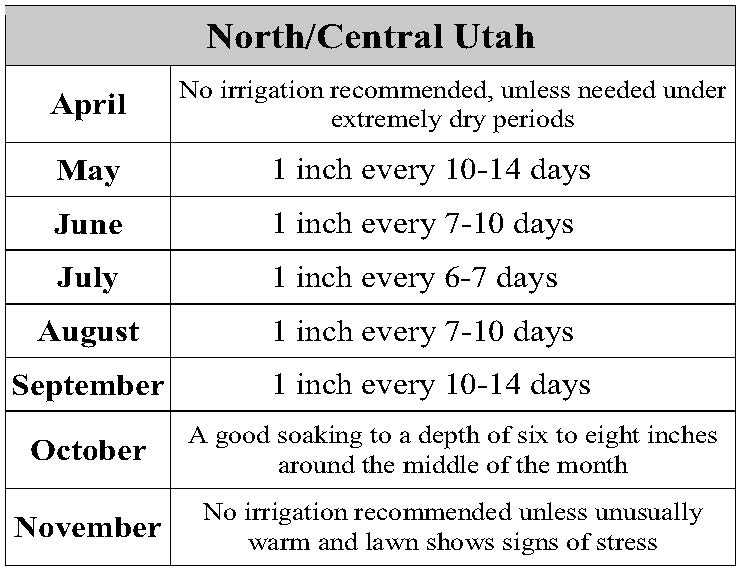
- Don’t water when there is precipitation in the forecast! Watering during a rain storm is one of the most idiotic things you can do. If you will not be available to shut off your system when it rains install a soil moisture sensor or Evapo Transpiration Sensor that will shut off your system automatically when it rains.
- Water longer and deeper. 1″ of water applied in one day every 8 days creates a stronger lawn than applying 1/4″ every other day. Deeper watering creates a deeper, stronger root system.
- Don’t set your system and forget it. The best way to decrease the amount of water you apply to your lawn is to shut off your automatic system and only water when your lawn shows signs of stress. If you cannot easily push a screwdriver into your soil about 6″ your soil is dry and you need to apply water. Also, if you can see footprints in your lawn after 60 seconds that is a sign that the blade structure is weak and the lawn needs water. Change the frequency and amount of water monthly to ensure that the lawn is not being over watered.
- Only water sections that need watering. If you have a single spot in your lawn that needs more water, use a hose-end sprinkler to water that spot rather than watering your whole yard.
After maintaining your lawn as recommended if your lawn is still struggling a turfgrass expert can evaluate your lawn to determine what best. They can test your soil composition, the efficiency of your irrigation system, and may recommend hand-weeding. pre-emergent herbicides, and post-emergent herbicides. While hand-weeding is by far the most tedious it is also the most environmentally friendly and effective method to get rid of weeds in your lawn. Herbicides have many uses but in all cases should be used sparingly.
To see the most common weeds for cool season lawns visit the Chanshare Lawn Care Guide at chanshare.com. If you have any specific question on how to Water-Wise your lawn please email sales@chanshare.com or call 866-SOD-EASY.